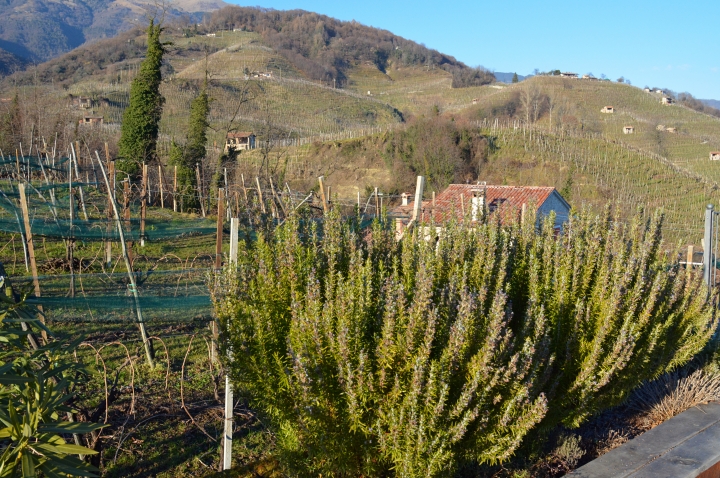There is a road you shouldn’t miss when you come in the Prosecco area. When you reach Valdobbiadene, after visiting some of the most important Prosecco wineries, after climbing the Mount Cesen, you must head to Santo Stefano, Guia, Combai, Miane and finally to Follina. This road will reveal to you the real nature of the Prosecco hills, one of the three hearts of the DOCG Prosecco, allowing you to understand why there is a difference between the Prosecco of the hills, “le colline” (the DOCG appellation area) and the Prosecco of the country, “la campagna” (the wider DOC appellation area).

Actually there are only two cru in the DOCG area, the Cartizze hill and the Rive, and this road will bring you in the Rive cru area. Nevertheless I must say that any of the hills passed by this winding road should have their own cru appellation, thanks to their special and unique exposure, steep, traditions, heritages. Any of the above mentioned villages have their own heritages and people are proud to be from their own hill. When the winemakers produce wine from their own hill only, these features trasfer into their wine creating, in my humble opinion, a cru.
My advice today is to simply take a bus ticket from Valdobbiadene to Follina, hop-on and hop-off at any of the above villages bus stop. You’ll have the chance to walk a little from the bus stops to the wineries, maybe climbing for about 15-20 minutes on nice country roads, visiting the wineries, wine tasting your best Dry or Brut, and then hop-on on the next bus ride for the next stop. You’ll be without any problem with police’s alchool test!

Today I stopped at Guia di Valdobbiadene, visiting the Azienda Agricola Canello . When you visit an “Azienda Agricola” you expect to find countrymen who run a family business on their own few tenths of hectares of vineyards.
That’s the case of the Azienda of Andrea Canello, who welcomes you at the top of a small steep road in a old country house where there is no separation between the house and the cellars, between the client’s tasting room and the owners dyning room, creating a very familiar athmosphere.

The cold winter time invites us to stay in the dyning room, heated by a nice fireplace, but on the roof top of the cellars a nice garden reveals a fantastic panorama of the hills all around, with the bell towers of Guia and Santo Stefano di Valdobbiadene laying on the footsteps of the Mount Cesen. I strongly recommend you to enjoy this fantastic location for few hours sipping the Canello’s Prosecco.
Andrea kindly presented the cellars to us, describing the process of wine making, discussing the choices made for its own oenological decisions: when starting the first fermentation in the tanks, the right temperature, why he decided to go for autoctones yeasts, the kind of sugar, the quantity of sulfites, the type of filtering systems and so on.

Andrea’s cellar have the tanks for the first fermentation, but the “presa di spuma” (the second fermentation, when the wine gets the bubbles) is done in the autoclave of a Partner. Andrea carefully checks this stage even if it is not done in the family’s cellar.

That’s one of the details that I love to check since a family owned business does not necessary invest in a fully geared cellar. As many “micro wineries”, Andrea’s one have what was the standard in the old times when the cellars used to sell the Prosecco to the clients that then use to do the second fermentation adding sugar and yeasts by themselves at home after bottling the wine.
This “sustainable” way to invest in wine allows microwineries to work without the pressure of return on investiments, keeping doing the things like their fathers use to do in the past.
Okay, the disciplinary of Prosecco, today, requires strict rules and Andrea produces Prosecco in the way we expect. The traditional Prosecco Spumantes (Dry, Extra Dry and Brut) and a special attention payed to the Frizzantes.

Actually Andrea’s production has a special passion for the Frizzante, produced with the champenoise method, with the second fermentation in the bottle after the wine is poured, normally arount Easter. This is the Prosecco that I feel closer to the traditions of my grandparents, the ancestral Prosecco, the one they used to ask in the osteria, with a evident taste of bread crust gave by the yeasts left in the bottle.


The wine tasting takes place in the dyning room, I had the chance to meet a nice and warm people from Sicily and Calabria. Sitting all together at the table, tasting all the range of the Andrea’s production, pairing with a local soppressa salami and home made bread got all of us out of the time.



I’ve loved to talk with new friends just met there, with Andrea, with her mother and with Andrea’s friend who joined us. Maybe the knowledge of the language should be a must, maybe you’d better learn a bit of dialect in order to understand Andrea’s mother, but you’ll be able to feel comfortable just after the first glass of bubbly.
A nice video describing the Canello Winery will definitely give you reasons not to miss this wonderful place.

